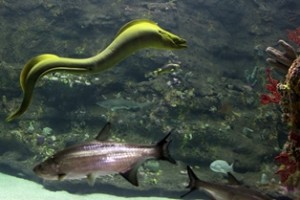Easy Being Green
For St. Patrick’s Day, we are going to highlight a few of our “green” animals living here at the N.C. Aquarium at Fort Fisher. Not all of these critters are turtles, or even reptiles, but learning about different types of animals is a great way for your students to compare and contrast between different species.

Our resident green sea turtle, Shelldon, isn’t green at all!
Have you ever noticed our green sea turtle, Shelldon, really isn’t that green? His shell and skin coloration is brownish. He does not get his name from what color he is on the outside, but what color he is on the inside. Adult green sea turtles eat a vegetarian diet made up of kelp, seagrass and algae. The green pigments found in these plants are what make a green sea turtles body fat tissue green. For St. Patrick’s Day, your class can make their own green sea turtle stomachs, using green food coloring to make them look green. Check out our Sea Turtle Stomach Dissection lesson plan for the recipe.

Add green food coloring to your stomach dissection recipe
Shelldon lives in our Cape Fear Shoals exhibit with many other fish, including the green moray eel. These fish are not very easy to see because they are nocturnal predators, so they often hide in the cracks and crevices of the coral. Even though these eels look the color of their name, they are not. They are actually a blue color with a layer of thick yellow slime. This mucus coating helps protect the eel from parasites and infection that could make it sick. The blue color of its body mixed with the yellow color of its slime makes the color of green!

A green moray eel swims in the Cape Fear Shoals exhibit, where Shelldon also lives
Green tree frogs are not reptiles, nor fish, but amphibians. Amphibians have some similarities with reptiles: both use lungs to breathe air, are vertebrates with backbones, are cold-blooded and lay eggs. However, there are many differences, as well. For instance, amphibians start their life cycle out in the water (with gills and tails) before metamorphosing into frogs or toads. Amphibians also have wet slimy skin, unlike a reptile’s scaly skin. The green tree frog can range in coloration from bright green to yellowish, lime green. They are green because they live in habitats with plenty of vegetation to camouflage like trees, grasses and ponds. If you’d like to learn more about amphibians and their importance to your area, check out an awesome citizen science program: FrogWatch USA. The NC Aquarium at Fort Fisher will be providing training opportunities for interested FrogWatch volunteers on March 19th and April 16th from 1pm – 5pm. If interested, sign up here.

A green tree frog on exhibit with other tree frogs
Can you think of other similarities or differences between reptiles, fish and amphibians? Maybe you can think of the differences and similarities reptiles have with humans? Check out our Reptilian Requirements lesson plan for a refresher on what makes an animal a reptile. Or your class can compare different animal life cycles with the Sea Turtle Timeline lesson plan.
Turtle A now weighs 830 grams and measure 17.5 cm long while Turtle B weighs 729 grams and measures 16.3 cm long. For other lesson plan ideas on how to use this data, visit Hatchling to Yearling.







